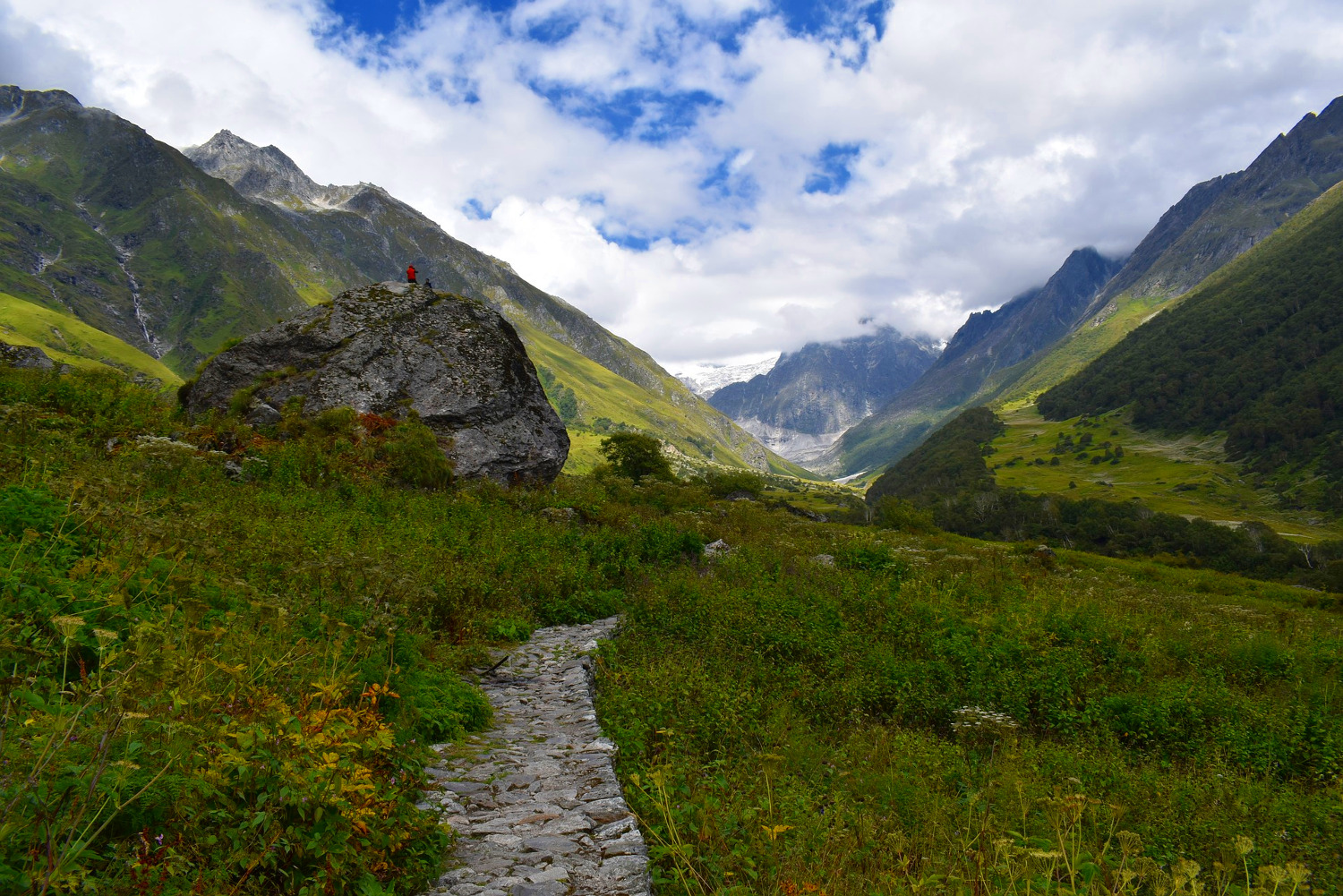
Flowerful Pastures
Often, in dark winter days, I wandered in spirit to these flowerful pastures with their clear-running streams set against a frieze of silver birches and shining snow peaks.
—Frank Smythe
High in the mountains, among windswept peaks and gleaming glaciers is a hidden bower where you can touch the sky. Floating like a secret benediction near the sacred site of Badrinath, it remained hidden for centuries. Despite it’s closeness to the ancient pilgrim paths, it was the exclusive preserve of flower-munching mountain goats and nomadic shepherds on their way through the valleys and passes to the dry hills of Tibet.
The rocky path to the high altitude (3300 – 3600 meter) glacial valley is steep, slippery and soggy. To see the flowers you must trek through the monsoon in the swirling clouds of the upper Himalaya. Entrance is restricted to a few hours a day. Dusk is but a brief interlude. Darkness falls like a curtain as the sun slips behind the towering walls of the gorge.
Where is it?
The Valley of Flowers National Park is in Garhwal near the Nanda Devi National Park in the Chamoli district, about 595 kilometers from Delhi. The tiny national park, all 87.5 square kilometers of it, is a UNESCO World Heritage Site. Compare this to the nearby Jim Corbett National park, at 520 square kilometers in the foothills below.
At an altitude that varies from 3000 meters to 6000 meters, the nearest airport is Jolly Grant Airport near Dehradun, about 300 kilometers away.
The nearest railway stations are Haridwar and Rishikesh, 276 kilometers away. From Rishikesh the only access is by road all along the sparkling Ganges, and then the pounding Alaknanda.
The sheltered aspect of the valley protects it from icy blasts, and melts the glaciers for a short season. For most of the year, it is a valley of glacier and rocks, but the monsoon works her magic. 500 different varieties of alpine flowers explode into bloom for a brief season from June to August. The flowers germinate, flower and seed in a 12-week period, in a sky-tossed valley surrounded by some spectacular peaks of the Himalayas.
The Valley of Flowers runs northwest to southeast, drained by the Pushpavati and it’s ice fed tributary streams which form a glacial corridor, a bare five kilometers long and two kilometers wide. This may not seem far, but at an altitude of above 3 kilometers up in the sky, it can be hard on lungs, knees and feet, so make sure you acclimatize before you go.
This book describes the route from Delhi to Hemkund and the Valley of the Flowers on a personal journey I made in August 2019.
Can I do the trek?
If you can walk at least a kilometer, you can do the trek as there are good support services, if you are unable to walk, hire a porter, or a pony. You can also take a helicopter from Govind Ghat to Ghangaria, depending on the weather.
From Govind Ghat to Ghangaria, is a moderate to difficult trek. The following are the stages:
- Gobind Ghat to Pulna – Steep. Take the share taxi.
- Pulna to the Bridge at Byundar, Moderate, well graded, but with a few steep twists and turns
– You can hire a porter for your luggage, or for yourself. Yes! you can ride up in a basket borne on the back of a porter!
– You can hire a pony for your luggage, or for yourself, and ride up on a well trained mule accompanied all the way by the pony wallah. - Byundar Bridge to Ghangaria Camp – Wind along an uphill path lined with and rhododendron. If the bridge is down, you may have to change ponies/porters here.
- Ghangaria Camp to Ghangaria – A short, but steep climb between towering Himalayan pines, with mossy rocks and flowers peeping out in the undergrowth.
- Ghangaria to Valley of Flowers checkpoint – Upward slope of about half a kilometer. You can hire a porter here to carry you up to the Valley. No ponies are allowed.
- Checkpoint to Pushpavati river crossing – Gentle downslopes to the boisterous river.
- Pushpavati crossing to Valley of Flowers -steep and winding 1.5 kms, followed by a gentler climb of 2 kms.
When can I see the flowers?
Snow and ice cover the Bhyundar valley or Valley of Flowers from October to May,. This includes access to bustling Ghangharia which turns into a ghost town from October to May.
You can trek from early June until the beginning of October. Check exact dates, as it depends on the ice melt. The best time to visit is from mid July to mid August, when the flowers are in full bloom. This is also the wettest part of the year, so add time for road closures. Day temperatures of 15 to 20 degrees C, falling to 8 to 10 degrees C by night, make for a cool trek. Layer clothing as it can get warm when trekking. Flowers include the majestic and protected Brahmakamal, lilies, anemones, primula, and the prized blue poppies, the blooms come in all colors and sizesm and change from month to month in waves of colour.
Anemone, Geranium, Marsh Marigold, Primula, Potentilla, Aster, Lilium,Himalayan Blue Poppy, Aconite, Delphinium, Ranunculus, Corydalis, Inula, Saussurea, Campanula, Pedicularis, Morina, Impatiens, Bistorta, Ligularia, Anaphalis, Saxifraga, Lobelia, Thermopsis, Trollius, Aquilegia, Codonopsis, Dactylorhiza, Cypripedium, Strawberries and Rhododendrons, Anaphalises and Potentillas, the unfamiliar names hide the sheer beauty of the flowers.
In May when the ice retreats, sweet scented primulas cover the rocky terraces in blue and snow white anemones light up the valley floor. With the arrival of monsoons in July in August, pink and red varieties flush the valley with rosy hues. Balsam, Wallich Geranium, and River Beauty, dominate the seasonal shades of yellow, purple and white.
From late July to the end of August, Pedicularis, Potentilla, Ligularia and many other yellow varieties dominate.
More information in the Appendix.
The Valley of Flowers, The Ultimate Guide to an Adventure Trek in the Upper Himalaya.
For excellent Book editing for authors, check out Derek Murphy’s site below.
